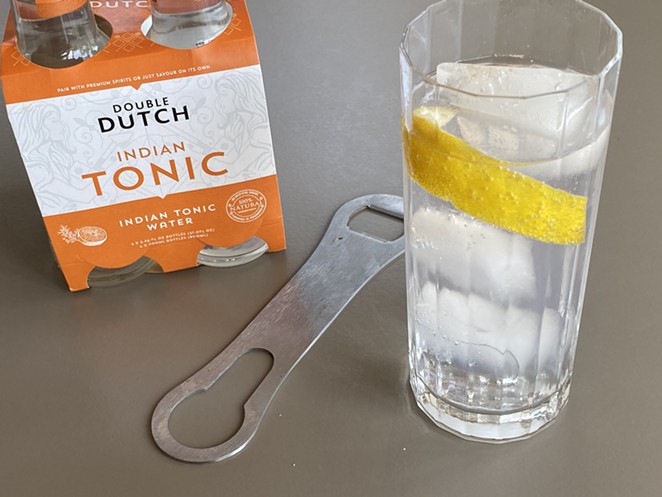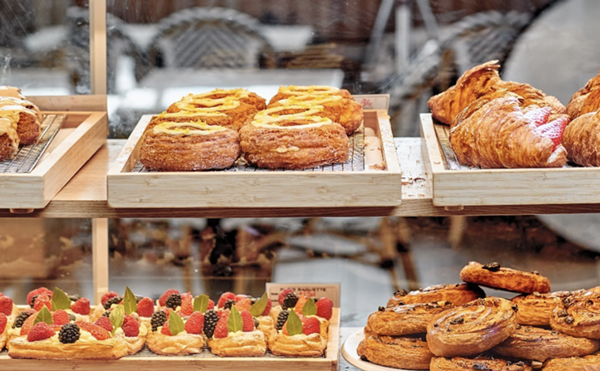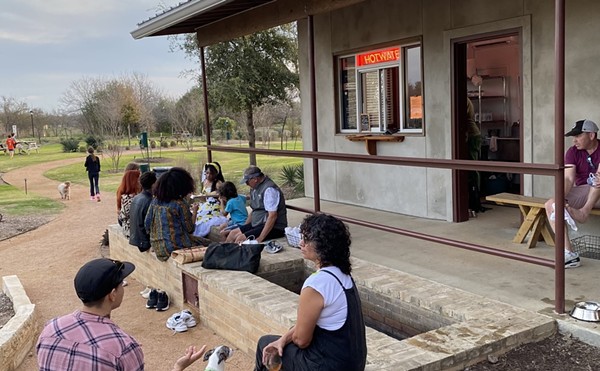Here for Highballs: No Shaker Required To Add These Classic Cocktails To Your Repertoire
By Ron Bechtol on Thu, Jun 25, 2020 at 1:00 pm
Here’s a little quiz for you: Which came first, the Scotch and soda, the gin and tonic or the Cuba Libre?
Actually, it’s kind of a trick question, but don’t panic.
The answer isn’t really all that important to this article, though you’ll find it, with qualifiers, embedded below. What’s important is that all three are a subset of a category known as built drinks — cocktails that are composed in their serving glass. No fancy shakers required.
Let’s call this subset highballs, though there are further distinctions, such as cobblers, but we won’t get into that here. Essentially, these cocktails are any drink served in a tall glass that combines liquor and water or a carbonated beverage.
I’m confident most of you are familiar with the gin and tonic, a drink invented in the mid-1800s to get British troops occupying India to take their quinine as a hedge against malaria. Ice, gin, a wedge of lime, tonic water poured on top, a slight stir. That’s it. The Spanish have recently popularized more elaborate versions, served in “balloon” goblets, often with added botanicals and fruits.
Tonic and gin play well together, but they aren’t monogamous. Try tonic with rum too — say 2 ounces of your rum of choice — or a mix of grassy, cane-based agricole with a classic Bacardi — and accessories such as an orange wheel and a sprig of mint. If you have some star anise, toss in one of those pods too.
While the Bacardi’s out, let’s talk Cuba Libre. The original drink, a symbol of Cuban fighters and their struggle for freedom from Spain, was likely a much rougher concoction made from sugar cane distillate with honey sweetener — no Coke (another colonizer) involved. Today’s drink had to wait for rum and coke to get together after Bacardi’s founding in 1862 and Coke’s invention in Atlanta in 1886. Lime came to the party even later. Here’s the result: 2 ounces rum — Bacardi Superior or Gold to be correct — plus 6 ounces Coca-Cola (Mexican to be incorrect), ice and a couple of wedges of lime squeezed and dropped into the glass. Stir. Drink while shouting “Por Cuba Libre!”
FYI, the first commercial carbonated water was produced in 1783 by the Swiss amateur scientist John Jacob Schweppes — sound familiar? We don’t know exactly when fizzy water and Scotch whisky first made contact, but the Scotch and soda’s debut appearance in the US is said to have occurred in 1895 when an English actor requested “a Scotch highball” at the Manhattan bar of one Patrick Duffy. One part Scotch, three parts soda, lemon wedge and ice: Bang! Variations include ginger ale, bitter lemon and, again, tonic.
The Japanese, utilizing their own whiskeys, have recently gone the other, more purist direction. A one-to four ratio of spirit to soda is likely, the size and shape of both glass (chilled, please, to reduce dilution) and ice are critical, a slow pour of soda and an equally slow stir — so that less gas escapes — are essential, and lemon is definitely considered optional. A reverential air in the stirring and sipping also helps.
Both tonic and soda waters make an appearance in the Gin Sonic, a drink said to have evolved from the gin and tonic and the whiskey highball. Take 1 ½ ounces gin, 2 ¼ ounces each of tonic and soda water, stir in a highball glass over ice and garnish with a lemon twist. Because it’s prettier. If it were up to me, I’d also add a couple drops of Angostura bitters — because it’s sexier. And because the gin is more forward in this drink than a conventional G&T, make sure it’s a good one.
Today’s Sea Breeze cocktail is nothing like the original, which dates from 1928 if one source is to be believed, and that cocktail of old went in a different, fruitier direction. It consisted of gin (2 ounces) and grenadine (1/4 ounce) stirred together with ice, then topped with 3 ounces of fresh grapefruit juice. House-made grenadine, consisting of equal parts pomegranate juice and sugar, simmered to dissolve the sugar, is highly recommended. Another early version of the drink eliminates the grapefruit in favor of apricot brandy and lemon juice and employs soda.) There may be nothing effervescent about this drink, but it gains freshness from the grapefruit and serves as a kind of bridge to other stirred-in-the glass cocktails to follow in a later article.
As for which came first, odds are that it’s Scotch and soda, but further research may be required.
So many restaurants, so little time. Find out the latest San Antonio dining news with our Flavor Friday Newsletter.
Actually, it’s kind of a trick question, but don’t panic.
The answer isn’t really all that important to this article, though you’ll find it, with qualifiers, embedded below. What’s important is that all three are a subset of a category known as built drinks — cocktails that are composed in their serving glass. No fancy shakers required.
Let’s call this subset highballs, though there are further distinctions, such as cobblers, but we won’t get into that here. Essentially, these cocktails are any drink served in a tall glass that combines liquor and water or a carbonated beverage.
I’m confident most of you are familiar with the gin and tonic, a drink invented in the mid-1800s to get British troops occupying India to take their quinine as a hedge against malaria. Ice, gin, a wedge of lime, tonic water poured on top, a slight stir. That’s it. The Spanish have recently popularized more elaborate versions, served in “balloon” goblets, often with added botanicals and fruits.
Tonic and gin play well together, but they aren’t monogamous. Try tonic with rum too — say 2 ounces of your rum of choice — or a mix of grassy, cane-based agricole with a classic Bacardi — and accessories such as an orange wheel and a sprig of mint. If you have some star anise, toss in one of those pods too.
While the Bacardi’s out, let’s talk Cuba Libre. The original drink, a symbol of Cuban fighters and their struggle for freedom from Spain, was likely a much rougher concoction made from sugar cane distillate with honey sweetener — no Coke (another colonizer) involved. Today’s drink had to wait for rum and coke to get together after Bacardi’s founding in 1862 and Coke’s invention in Atlanta in 1886. Lime came to the party even later. Here’s the result: 2 ounces rum — Bacardi Superior or Gold to be correct — plus 6 ounces Coca-Cola (Mexican to be incorrect), ice and a couple of wedges of lime squeezed and dropped into the glass. Stir. Drink while shouting “Por Cuba Libre!”
FYI, the first commercial carbonated water was produced in 1783 by the Swiss amateur scientist John Jacob Schweppes — sound familiar? We don’t know exactly when fizzy water and Scotch whisky first made contact, but the Scotch and soda’s debut appearance in the US is said to have occurred in 1895 when an English actor requested “a Scotch highball” at the Manhattan bar of one Patrick Duffy. One part Scotch, three parts soda, lemon wedge and ice: Bang! Variations include ginger ale, bitter lemon and, again, tonic.
The Japanese, utilizing their own whiskeys, have recently gone the other, more purist direction. A one-to four ratio of spirit to soda is likely, the size and shape of both glass (chilled, please, to reduce dilution) and ice are critical, a slow pour of soda and an equally slow stir — so that less gas escapes — are essential, and lemon is definitely considered optional. A reverential air in the stirring and sipping also helps.
Both tonic and soda waters make an appearance in the Gin Sonic, a drink said to have evolved from the gin and tonic and the whiskey highball. Take 1 ½ ounces gin, 2 ¼ ounces each of tonic and soda water, stir in a highball glass over ice and garnish with a lemon twist. Because it’s prettier. If it were up to me, I’d also add a couple drops of Angostura bitters — because it’s sexier. And because the gin is more forward in this drink than a conventional G&T, make sure it’s a good one.
Today’s Sea Breeze cocktail is nothing like the original, which dates from 1928 if one source is to be believed, and that cocktail of old went in a different, fruitier direction. It consisted of gin (2 ounces) and grenadine (1/4 ounce) stirred together with ice, then topped with 3 ounces of fresh grapefruit juice. House-made grenadine, consisting of equal parts pomegranate juice and sugar, simmered to dissolve the sugar, is highly recommended. Another early version of the drink eliminates the grapefruit in favor of apricot brandy and lemon juice and employs soda.) There may be nothing effervescent about this drink, but it gains freshness from the grapefruit and serves as a kind of bridge to other stirred-in-the glass cocktails to follow in a later article.
As for which came first, odds are that it’s Scotch and soda, but further research may be required.
So many restaurants, so little time. Find out the latest San Antonio dining news with our Flavor Friday Newsletter.
Tags:
- San Antonio,
- Texas,
- cocktail,
- recipe,
- highball,
- gin,
- tonic,
- scotch,
- soda,
- sea breeze,
- Cuba libre,
- Gin Sonic

KEEP SA CURRENT!
Since 1986, the SA Current has served as the free, independent voice of San Antonio, and we want to keep it that way.
Becoming an SA Current Supporter for as little as $5 a month allows us to continue offering readers access to our coverage of local news, food, nightlife, events, and culture with no paywalls.
Scroll to read more Flavor articles
Newsletters
Join SA Current Newsletters
Subscribe now to get the latest news delivered right to your inbox.

















